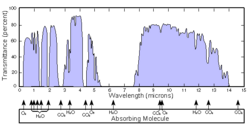
The emissivity of the surface of a material is its effectiveness in emitting energy as thermal radiation. Thermal radiation is electromagnetic radiation that most commonly includes both visible radiation (light) and infrared radiation, which is not visible to human eyes. A portion of the thermal radiation from very hot objects (see photograph) is easily visible to the eye.
Contents
- Practical applications
- Mathematical definitions
- Hemispherical emissivity
- Spectral hemispherical emissivity
- Directional emissivity
- Spectral directional emissivity
- Emissivities of common surfaces
- Closely related properties
- Absorptance
- Emittance
- Measurement of Emittance
- Emissivities of planet Earth
- Surface
- Atmosphere
- Effective emissivity due to atmosphere
- History
- Other radiometric coefficients
- See also
- References
- Further reading
The emissivity of a surface depends on its chemical composition and geometrical structure. Quantitatively, it is the ratio of the thermal radiation from a surface to the radiation from an ideal black surface at the same temperature as given by the Stefan–Boltzmann law. (A comparison with Planck's law is used if one is concerned with particular wavelengths of thermal radiation.) The ratio varies from 0 to 1 for ordinary surfaces.
The surface of a perfect black body (with an emissivity of 1) emits thermal radiation at the rate of approximately 448 watts per square metre (W/m2) at a room temperature of 25 °C (298 K; 77 °F).
Real objects have emissivities less than 1.0, and emit radiation at correspondingly lower rates. [1]
However, wavelength- and subwavelength-scale particles, [2] metamaterials, [3] and other nanostructures [4] may have an emissivity greater than 1, at least for near-field effects.















